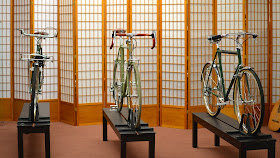by Igor
So we delve into the world of frame preparation, mostly to answer questions we've had after Bruce Gordon's
recent post about how some well known frames are delivered to the customer with no prep at all.
Back in the days of classic frames when you took delivery of your new frame it often had to go under the knife to fix alignment issues and other imperfections. It's almost impossible to build a steel frame that doesn't require some prep, though some are much better than others. The new owner would be expected to take the brand-new frame to a mechanics to ream and face the head tube to remove excess metal/paint so that the headset cups seated parallel to each other. The bottom bracket required the same process, in addition to cleaning up the threads of burrs and significant excess paint. The seat tube needed to have burrs removed in order to smoothly insert the seat post. Finally, dropouts required alignment to make sure the hub/rim/tires fit properly. This trend continued well into the 80s, especially with your super Italian racing bikes. Many frame builders assumed these preparations would be completed at the shop.
Our frames are made in what is possibly the best factory in Taiwan. A factory that truly puts quality construction first. The whole process of facing, reaming, tapping, and aligning are all done before the frame leaves the factory. Alignment is done on huge heavy duty machines and work tables that are very resistant to warping or going out of true. Even the best custom builders don't have access to tools like these.
On VO frames headsets can be pressed in, bottom brackets threaded, and seat posts installed without worry of burrs or cracked cups or improper alignment. What does this mean? It means that you, the customer, don't have to spend additional money on your frame, upwards of $75, purely for prep. To the shop, it means less time to build up the bike, and therefore less money spent on labor.
 |
| Frame tools at the VO shop. |
Of course you can still have the frame prepped if you want. It's possible the frame has been damages in shipping or dropped, but in practice we almost never see that. And I'll bet the shop's tools are not as accurate as the factory's. It's up to you in the end whether you will sleep better at night if you have your frame prepped. So do you go through these steps when you take delivery of a new frame?
 Speaking of Interbike, we'll be introducing a new frame. Details soon. But here's a hint, Igor just built the wheel below to fit it. And that's a new VO Rim.
Speaking of Interbike, we'll be introducing a new frame. Details soon. But here's a hint, Igor just built the wheel below to fit it. And that's a new VO Rim.













